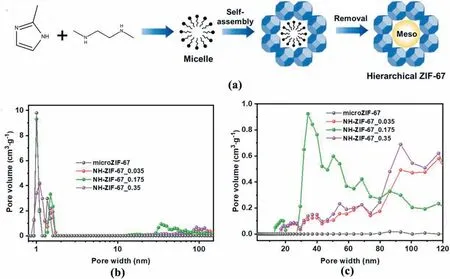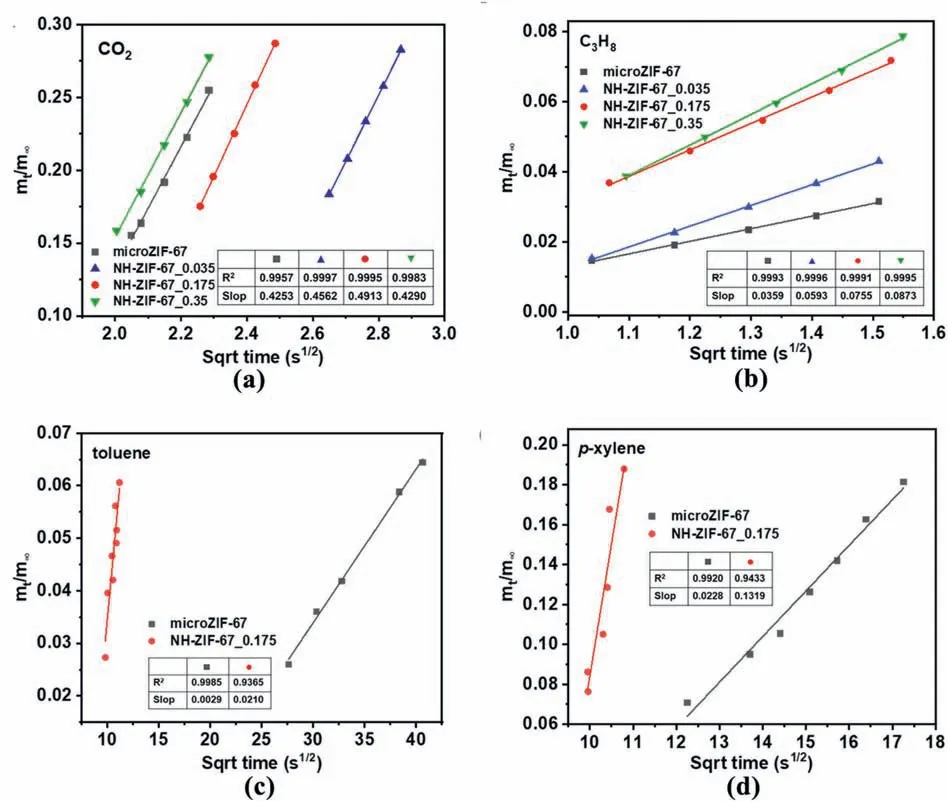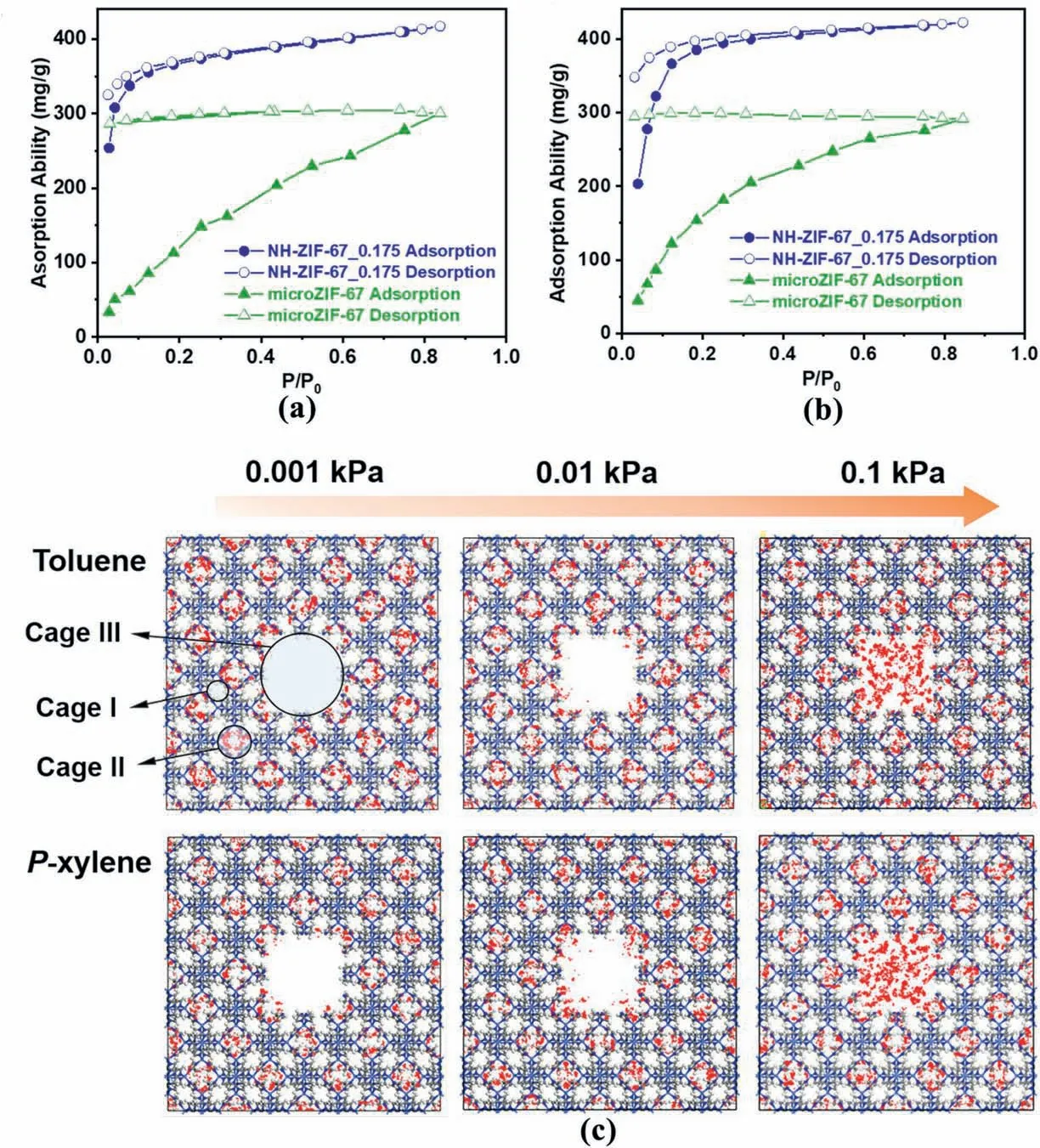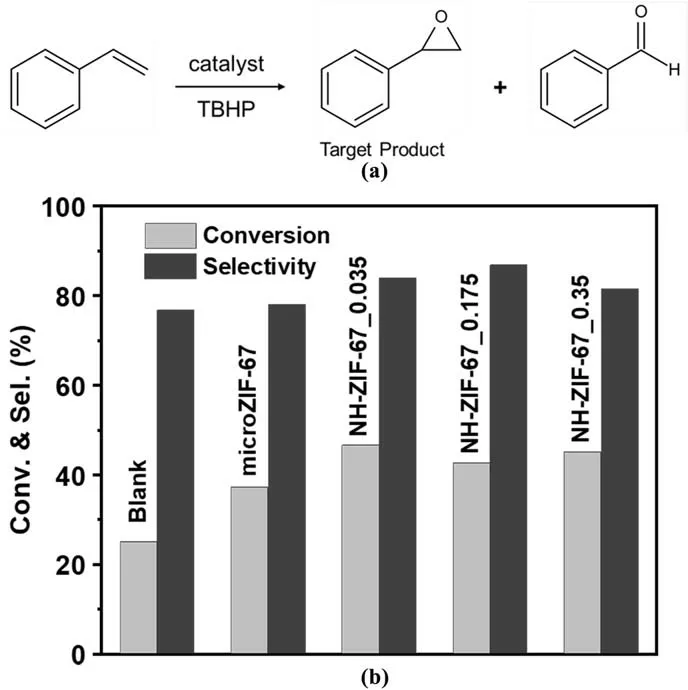Water-based synthesis of nanoscale hierarchical metal-organic frameworks:Boosting adsorption and catalytic performance
Yi Yu,Zewei Liu,Xiofei Chen,Shujun Liu,Chongxiong Dun,Hongxi Xi,c,**
a School of Chemistry and Chemical Engineering,South China University of Technology,Guangzhou,510640,PR China
b School of Materials Science and Hydrogen Engineering,Foshan University,Foshan,528231,PR China
c Guangdong Provincial Key Laboratory of Atmospheric Environment and Pollution Control,South China University of Technology,Guangzhou Higher Education Mega Centre,Guangzhou,510006,PR China
Keywords: Nanoscale hierarchical metal-organic framework Water-based synthesis Volatile organic compounds Olefins oxidation
ABSTRACT The combination of nano sizes,large pore sizes and green synthesis is recognized as one of the most crucial and challenging problems in constructing metal-organic frameworks (MOFs).Herein,a water-based strategy is proposed for the synthesis of nanoscale hierarchical MOFs(NH-MOFs)with high crystallinity and excellent stability.This approach allows the morphology and porosity of MOFs to be fine tuned,thereby enabling the nanoscale crystal generation and a well-defined hierarchical system.The aqueous solution facilitates rapid nucleation kinetics,and the introduced modulator acts as a deprotonation agent to accelerate the deprotonation of the organic ligand as well as a structure-directing agent (SDA) to guide the formation of hierarchical networks.The assynthesized NH-MOFs (NH-ZIF-67) were assessed as efficient adsorbents and heterogeneous catalysts to facilitate the diffusion of guest molecules,outperforming the parent microZIF-67.This study focuses on understanding the NH-MOF growth rules,which could allow tailor-designing NH-MOFs for various functions.
1.Introduction
Metal-organic frameworks (MOFs) are an emerging type of porous crystalline material consisting of metal ions or ion clusters with organic ligands through a coordinate function [1].Compared with some traditional porous materials,such as activated carbon,zeolites,and polymers,MOFs enable exact framework structure design and pore environments,particularly at the molecular level,to suit various applications including gas storage,adsorption/separation,chemical sensing,drug delivery,and catalysis[2-9].
The guest diffusion improvement in pore spaces is of great interest.Two main approaches have been developed to improve the guest diffusion as well as the mass transfer of MOFs,namely,the expansion of pore size by building hierarchical structures and the reduction of crystal size[10-12].Hierarchical networks preserve high surface area and abundant active sites of microporous structures,and the introduction of mesopores and/or macropores promotes the diffusion and accessibility of guest molecules [13,14].Several techniques for preparing hierarchical MOFs have been reported,including ligand extension [15],post-modification[16],template [17,18],defect [19],and spray-drying methods [20].Furthermore,reducing the pore blockage kinetics by shrinking the bulky crystals to the nanoscale can reduce the diffusion path of guests to the interior.Nanotechnology of MOFs is of tremendous interest,especially considering potential applications such as catalysis and drug delivery[21,22].For example,the crystal size of MOFs influences the assembly behavior into separation membranes,exposure of active sites and drug dispersion in a given medium[23].Therefore,it is of critical importance to construct mesoporous spaces into microporous materials while maintaining crystal size with insignificant change in the designed physicochemical properties.
Nanoscale hierarchical MOFs (NH-MOFs) have emerged as representatives of the fascinating field where the hierarchical structure meets the nanotechnology [24].Bottom-up strategies (e.g.,mixed-ligand method,template method,perturbation-assisted synthesis,andin-situsynthesis)have attracted considerable attention for fabricating NH-MOFs as the porosity and crystal size can be readily tailored by controlling the reaction parameters [10,25],thereby avoiding some complex post-modification processes,such as etching or linker labilization [26,27].One of the most effective approaches for preparing NH-MOFs containing high crystallinity is to accelerate the nucleation stage of crystals by tuning the synthetic environment and introducing additives to guide the formation of mesopores.Acids (e.g.,inorganic and fatty acid) [28],surfactants[29],amines[24]and segmented copolymers[30]can act as a template or/and a modulator for the generation of mesopores.In previous studies,we have focused on optimizing reaction conditions,mechanism research and better adsorption/catalytic abilities in the synthesis of hierarchical MOFs and NH-MOFs [29,31-34].The organic solvent is unavoidable,despite the unprecedented space-time yield achieved.Water is unquestionably the most obvious choice for any green reaction.Indeed,to the best of our knowledge,none of the NH-MOFs has been fabricated in an aqueous environment with potential industrial applications.
Herein,a templating and rapid synthesis method is demonstrated to prepare NH-MOFs in the aqueous phase.As shown in Fig.1a.ZIF-67,one of the most investigated MOFs,was introduced as an example to validate our strategy because of its outstanding stability and good tolerance toward large porosity [35].The resultant NH-ZIF-67 exhibited micro-,meso-and macropores,together with excellent thermal/mechanical stability.Moreover,NH-ZIF-67 showed enhanced diffusion rates in adsorption/catalysis tests,especially for larger molecules,compared with the conventional ZIF-67.

Fig.1.(a)Schematic of the fabrication of NH-ZIF-67 sample and(b–c)pore size distributions of the as-synthesized NH-ZIF-67_X(X=0.035,0.175,and 0.35)samples.
2.Experimental section
2.1.Chemicals
Cobalt nitrate hexahydrate (Co(NO3)2⋅6H2O,99%),2-methylimidazole (2-Im,99%),methanol (CH3OH,99.5%),N,N-dimethyl ethylenediamine (98%),ethanol (CH3CH2OH,99.7%),styrene (99%),tbutylhydroperoxide (TBHP,70 wt% in decane),chlorobenzene (99.5%)were purchased from J&K or Aladdin Chemical Ltd.All chemicals were commercially available and used as received without further treatment.
2.2.Material preparation
2.2.1.Synthesis of microporous ZIF-67
Typically[36,37],1.16 g of Co(NO3)2⋅6H2O was dissolved in 100 mL of methanol,and 1.31 g of 2-methylimidazole (2-Im) was added in 100 mL of methanol,then the solutions were mixed under rapid magnetic agitation and continued stirring at room temperature for 2 h.Then the product was collected by centrifugation and washed several times with ethanol.The resulting products were dried in a vacuum at 60ºC for 6 h and then in an oven at 120ºC for 12 h.The obtained product was denoted as microZIF-67.
2.2.2.Room temperature and rapid synthesis of hierarchical ZIF-67
In the experiment,6 g of 2-Im andX(X=0.035,0.175,and 0.35)MN,N-dimethyl ethylenediamine were added into a 22 mL of deionized water solution,followed by a 10 min stir.Subsequently,0.5 g of Co(NO3)2⋅6H2O was dissolved in 4 mL of deionized water,and poured into the above solution and then stirred for 1 min.The mixture was immediately collected by vacuum filtration,washed with water and methanol,and then dried at 120°C overnight.The resulting products were labeled as NH-ZIF-67_X(X=0.035,0.175,and 0.35).In addition,the product obtained in the comparison experiment without addingN,N-dimethyl ethylenediamine was marked as ZIF-67_A.
2.3.Characterization
Power X-ray diffraction (XRD) patterns were recorded on a D8 ADVANCE (Bruker,Germany) using a step scan model with a range of 5–50°with CuKα radiation.Fourier transform infrared (FT-IR) spectra were measured using a Vector 33(Bruker,Germany)spectrometer with a resolution of 4 cm-1.Nitrogen adsorption and desorption measurements were done at 77 K using an ASAP2460(Micrmoeritics)after a degassing at 120°C for 6 h under vacuum.The apparent surface area was calculated using the BET (Brunauer-Emmett-Teller) equation and the pore size distribution was analyzedviathe Nonlocal-density functional theory(NLDFT) method.Scanning electron microscope (SEM) images were obtained on an HITACH (SC8820,Japan).Transmission electron microscopy(TEM)images were obtained using a JEM-2100HR(JEOL,Japan).The X-ray photoelectron spectroscopy (XPS) data was recorded on a Thermo ESCALAB 250Xi X-ray photoelectron spectrometer.Thermogravimetric and differential thermogravimetry(TG-DTG)was performed by a TGA 550(TA Instruments)between 25°C and 900°C at a heating rate of 5 K min-1in a nitrogen atmosphere.Nanoindentation experiments were performed on a TI-950(Bruker,Germany)after a first cold-mounted process using an epoxy resin and then a polish treatment by using increasingly fine diamond suspensions.
2.4.Adsorption measurements
The adsorption isotherms of carbon dioxide (CO2) and propane(C3H8) at 298 K were measured on a 3Flex Surface Characterization Analyzer(Micromeritics).The kinetic adsorption of CO2and C3H8were conducted at 308 K on TGA 550.The isotherm adsorption and kinetic adsorption of toluene andp-xylene at 298 K were inspected on BSD-VVS.
2.5.Epoxidation reaction of styrene
Typically,the flask was charged with styrene (2 mmol),TBHP (1.8 mmol)and ZIF-67 samples(10 mg).The reaction mixture was stirred at 80ºC for 12 h.The progress of the reaction was monitored by analyzing regularly taken aliquots with GC usingn-dodecane as the internal standard.
3.Results and discussion
NH-ZIF-67 samples were prepared via a facile templating method in aqueous phase at room temperature,as illustrated in Fig.1a.The positions of all diffraction peaks in as-synthesized samples given by XRD matched those in the simulation data,indicating that the ZIF-67 framework was successfully formed(Fig.S1).The porosity of each sample was evaluated using N2sorption measurements.Fig.S2 shows that NH-ZIF-67_Xsamples exhibited an obvious hysteresis loop at higher relative pressures(P/P0>0.8),indicating the existence of a typical mesoporous structure with pore sizes ranging from 13 to 50 nm when compared with microZIF-67 and ZIF-67_A which showed typical Type-I adsorption isotherms (Fig.1b–c and Fig.S3).The results demonstrated that the addition of a template is crucial to fabricating hierarchical channels.Moreover,the shape and size of the hysteresis loops of NH-ZIF-67_Xcorrespond to the volume and structure of mesopores,depending on the amount of surfactant [38].Interestingly,the microporous volume of NH-ZIF-67_Xwas about 0.67 cm3g-1,which was similar to microZIF-67(0.67 cm3g-1);therefore,the product NH-ZIF-67_0.175 with the highest mesoporous volume (0.35 cm3g-1) exhibited the best specific surface area(1974 m2g-1)and highestVmeso/Vmicroamong the analyzed samples(Fig.S4 and Table S1).These results revealed that the excellent directing function can only be attained when a suitable amount of surfactant is employed [39,40],because few surfactants can only partially direct the structure,whereas numerous surfactants will occupy a large amount of space in the reaction system,reducing the likelihood of metal ions contacting mesoporous precursor substances.Therefore,the structural properties of ZIF-67 materials can be regulated by controlling the amount of surfactant used in the synthesis.
Fig.2 shows the shape variation of as-synthesized ZIF-67 samples.Clearly,an irregular morphology with obvious defects and nanosize(100–300 nm) was formed in an aqueous solution,whereas a very smooth surface and larger particle size (700–900 nm) were observed in microZIF-67.As shown in Fig.S5,nanocrystals can form without adding templates,but the nucleation kinetic in water was faster than that in methanol [41].TEM images gave further evidence for the mesoporous network formation.When the template was added,the crystals exhibited the internal mesopores and inter-particle voids by the packing of crystals,compared with the compact state of microZIF-67(Fig.2a).Notably,when introducing the hierarchical structures,the chemical composition and chemical states of surface elements (C,N,O,and Co) were barely modified,as confirmed by XPS measurement (Fig.S6),in which a negligible shift of binding energy was observed.

Fig.2.SEM (left),TEM (middle) and size distribution (right) of (a) microZIF-67,(b) NH-ZIF-67_0.035,(c) NH-ZIF-67_0.175 and (d) NH-ZIF-67_0.35.
Excellent stability of MOFs is one of the prerequisites for their practical application [42].TGA analysis (Fig.3a) revealed that hierarchical samples showed two major weight loss regions at the same temperatures as their microporous analogues.Specifically,the first weight-loss stage was associated with the removal of a large number of guest molecules from 40ºC to 500ºC,and the second weight-loss stage occurred at around 500°C,where the curve showed a sharp decline,indicating the beginning of thermal decomposition and the collapse of the metal-organic skeleton[43].This was further confirmed by DTG curves which showed a strong heat absorption response within the temperature range of 510°C–560°C(Fig.S7).This indicated that the introduction of mesopores did not negatively affect the MOF's thermal stability.In addition,the excellent chemical stability of NH-ZIF-67_0.175 was confirmed via the XRD analysis,in which the characteristic peaks of the sample after being immersed in deionized water and different organic solvents(e.g.,toluene,p-xylene,dimethyl formamide,tetrahydrofuran,acetonitrile and methanol) were maintained (Figs.S8–S9).The representative load-displacement (P-h)curve of NH-ZIF-67_0.175 was evaluated through nanoindentation tests.Fig.3b showed that the hierarchical material can withstand relatively low loads (Pmax=35.8 μN) and underwent a lower extent of elastic recovery than previously reported ZIF materials [23].This can be attributed to the structures with large porosity [44].Moreover,the as-prepared NH-ZIF-67_0.175 samples can offer moderate mechanical properties among ZIF-type materials(E=6.2 GPa and H=0.32 GPa),as shown in Fig.S10.

Fig.3.(a) TGA curves of ZIF-67 samples,(b) and the representative load-displacement (P-h) curve for NH-ZIF-67_0.175.
When the reaction time was gradually prolonged,no significant change in the nano size and hierarchical architecture was observed(Figs.S13–S14).In addition,the molar ratio among Co2+,2-Im,and H2O was varied to further understand the growth of NH-ZIF-67 crystals with templating and rapid technique and discovered that the product obtained under a Co2+/2-Im/H2O ratio of 1:43:1700 was a microporous material with the highest crystallinity among the investigated products(Figs.S16–S17),which is inconsistent with the previous report on ZIFs[45].This result might be attributed to the structure-directing function of the template,which is greatly weakened at lower concentrations,as well as the formation of strong coordination bonds between ligands and metals [46],which is promoted by deprotonation,therefore facilitating the crystallization of products.In addition,an increase in the concentration of the precursor solution can decrease the size of crystals and may lead to additional surface defects,as shown in Fig.S18.Furthermore,when the surfactant was added after precursors were mixed,the as-synthesized product exhibited a larger crystal size and very few mesopores(Figs.S21–S22).This is because invariable pores formed when the ligands and metal salts were combined,substantially reducing the influence of the later added template.It can be inferred that the surfactant can guide the generation of meso-and macropores,but it cannot change the size of generated pores[47].
The alkaline condition favored deprotonation of 2-methylimidazole(Fig.S23).However,under a higher alkalinity environment (pH >9.0),the as-synthesized ZIF-67 samples exhibited decreasedVmesoand increasedVmicro,which could be because its ligands’deprotonation and their combination with metal ions is substantially promoted using the stronger alkalinity,rather than the template (Fig.S24).The assynthesized ZIF-67 showed poor textural properties when the synthetic system was adjusted to the neutral condition(Table S4),and no products were obtained in acidic conditions.This can be attributed to the destruction of template and the slow deprotonation process of ligands in an acidic system [48].These results showed that the weak alkaline condition is more beneficial to the production of high-quality hierarchical ZIF-67 materials.
Therefore,on the basis of the aforementioned experimental results and previously reported findings [49-53],it can be concluded that an aqueous solution and template are crucial.By introducing the aqueous solution,the nucleation and growth kinetics can be much improved,thus making it possible to design nanoscale crystals with abundant surface defects.The templateN,N-dimethyl ethylenediamine played a crucial dual role in the synthesis of hierarchical ZIF-67:acting as a deprotonation agent to accelerate the deprotonation of the organic ligand and guiding the formation of the hierarchical network as a structure-directing agent.
Notably,the synthesis strategy can be extended to the fabrication of other NH-MOFs,such as nanoscale hierarchical ZIF-8 (NH-ZIF-8) and nanoscale hierarchical Cu-BTC (NH-Cu-BTC).As shown in Fig.S25,the XRD spectra of the obtained sample was in good agreement with the simulated pattern,confirming that the as-synthesized product was crystalline ZIF-8.In addition,the combination of N2sorption isotherm and SEM image of the crystal demonstrated the presence of hierarchical structure and nanoscale morphology (Figs.S26–S27).Similarly,the obtained NH-Cu-BTC also showed a high degree of crystallinity,a hierarchically porous structure and nano size,as proved by a complementary combination of XRD,N2sorption isotherm,pore size distribution,and SEM analysis (Figs.S28–S30).These results indicated that the waterbased and template strategy has generality,which may encourage the large-scale industrial preparation of other nanoscale hierarchical MOFs with potential applications.
To explore the accessibility of the mesopores generated using templating and rapid synthesis,guest uptake tests were conducted.For small molecules such as CO2,the uptake capacity of samples at low operational pressures is mainly dependent on the surface area (Fig.S31).However,the porosity of materials takes the lead in guest diffusion and mass transfer.For example,the diffusion time constant(D′)of CO2within NHZIF-67_0.175 was 0.021 s-1at 308 K,higher than that of microZIF-67(0.016 s-1) after fitting the dynamic adsorption profiles with the micropore diffusion model.As shown in Fig.4b,similar improvement also can be observed in the adsorption towards C3H8.The corresponding value D’of microZIF-67 and NH-ZIF-67_0.175 were 1.12×10-7s-4and 4.97×10-7s-4,respectively.

Fig.4.Fitting of diffusion time constants of(a)CO2 and(b)C3H8 on microZIF-67 and NH-ZIF-67_X at 308 K,and(c)toluene and(d)p-xylene on microZIF-67 and NHZIF-67_0.175 at 298 K.
When larger molecules are involved,there is a more evident improvement in uptake capacity and mass transfer in the hierarchical environment.Hierarchically porous MOFs have been demonstrated to be promising adsorbents for the removal of volatile organic compounds(VOCs)because of their excellent properties such as high surface area and porosity[54,55].In this regard,toluene andp-xylene were used as probe molecules.It can be directly visualized from Fig.5a and b that the curves of NH-ZIF-67_0.175 towards toluene andp-xylene showed a steep increase at low relative pressures(P/P0<0.01)and then reached a plateau phase.The toluene uptake increased considerably at high relative pressures (P/P0>0.6),corresponding to a type-IV isotherm.Inversely,the curve of microZIF-67 entirely shows a different trend.Surprisingly,the toluene adsorption capacity of NH-ZIF-67_0.175 is consistently larger than that of microZIF-67 at the same pressure and that can be ascribed to its more active sites emerging from defects because their micropore specific surface areas are similar.For example,whenP/P0=0.9,the adsorption capacity of NH-ZIF-67_0.175 toward toluene is 417.2 mg g-1,which is 1.38 times that of microZIF-67(300.5 mg g-1)and also greatly that of other porous materials(Fig.S33)[56-62].

Fig.5.Sorption isotherms of(a)toluene and(c)p-xylene at 298 K on NH-ZIF-67_0.175 and microZIF-67.(c)Adsorption density distribution of toluene and p-xylene in NH-ZIF-67_0.175.
NH-ZIF-67_0.175 achieved the adsorption saturation level faster than microZIF-67 (7.34 × 10-7s-1) with D’ of 3.85 × 10-5s-1towards toluene,which is at least two orders of magnitude greater.Meanwhile,the corresponding values of NH-ZIF-67_0.175 forp-xylene was 1.52 ×10-3s-1,which was higher than that of microZIF-67(4.54×10-5s-1).The considerable hysteresis phenomenon for the desorption curve of microZIF-67 towards toluene andp-xylene demonstrated that the captured molecules were difficult to break away from the pores.
Fig.5c showed the adsorption density simulation of toluene andpxylene in NH-ZIF-67_0.175.The diameter of cage I calculated by Zeo++code was 0.334 nm,which is not enough to accommodate large molecules.Thus,at low pressure,toluene molecules mainly centred in cage II(micropores),where π-π stacking conjugate interactions between ligands and toluene molecules played a dominant role.As the pressure increased,toluene molecules began to be distributed in mesoporous cage III.A similar phenomenon was observed in thep-xylene motion.These results indicated that the introduced mesopores can provide additional defects and accommodation for guest adsorption.
The unique properties of NH-ZIF-67 such as nanoscale,high porosity and defects stimulated our interest in investigating its catalytic performance.ZIF-67 has been used as the catalyst for epoxidation of an alkene with benefits of large surface area,high porosity and low cost [63,64].The catalytic performance of the as-synthesized ZIF-67 samples for the epoxidation reaction was investigated,using styrene as the model substrate and TBHP as an oxidant(Fig.6a).As can be seen in Fig.6b,the addition of microZIF-67 can enhance the conversion of styrene(37.2%)compared with a blank reaction(25.1%),whereas the selectivity of styrene oxide showed no evident improvement.With the construction of mesopores and nano size,the conversion and selectivity catalyzed by NH-ZIF-67_0.175 can achieve 42.6% and 86.9%,respectively.Other nanosized hierarchical samples also showed enhanced catalytic activity,thereby indicating that the nanoscale morphology and hierarchical structure played a critical role in catalytic activity.

Fig.6.(a)Catalytic oxidation of styrene to styrene oxide.(b)Styrene oxidation catalyzed by ZIF-67 catalysts(reaction conditions:styrene(1.9 mmol),catalysts(10 mg),TBHP in decane (1.8 mmol),80 ºC,12 h).
4.Conclusions
In summary,a water-based strategy was developed to prepare nanoscale hierarchical ZIF-67(NH-ZIF-67),in which the mesoporous systems,morphologies and crystallinities could readily be fine-tuned by controlling the template volume ratio,precursor concentration,and alkalinity of the reaction system.The synthesis strategy can be extended to the fabrication of nanoscale hierarchical ZIF-8 and nanoscale hierarchical Cu-BTC.By fabricating a suitable nanosized and hierarchical network,leading NH-ZIF-67 samples exhibited enhanced adsorption properties and catalytic performances,especially for large molecules.The findings are expected to aid in understanding the growth of nanosized hierarchical materials,and taking advantage of this strategy,more NH-MOFs with multifunctional applications can be expected to be designed.
Notes
The authors declare no competing financial interest.
Acknowledgments
We gratefully acknowledge the financial support from the National Key Research and Development Program (2019YFC1805804),the National Natural Science Foundation of China(22008032),the Guangdong Natural Science Foundation(2022A1515011192),the Guangdong Basic and Applied Basic Research Foundation (2019A1515110706),the Guangdong Provincial Key Lab of Green Chemical Product Technology(GC202111),and the China Postdoctoral Science Foundation(2021M691059).
Appendix A.Supplementary data
Supplementary data to this article can be found online at https://doi.org/10.1016/j.nanoms.2022.09.002.
- Namo Materials Science的其它文章
- MXene-based flexible pressure sensor with piezoresistive properties significantly enhanced by atomic layer infiltration
- Construction of all-organic low dielectric polyimide hybrids via synergistic effect between covalent organic framework and cross-linking structure
- Synergistic coupling of 0D–2D heterostructure from ZnO and Ti3C2Tx MXene-derived TiO2 for boosted NO2 detection at room temperature
- Addressing cation mixing in layered structured cathodes for lithium-ion batteries: A critical review
- Wearable and stretchable conductive polymer composites for strain sensors:How to design a superior one?
- An overview of recent progress in the development of flexible electrochromic devices

